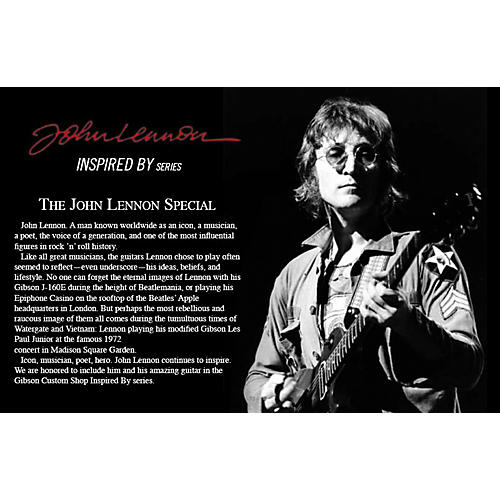Why Shop With Us?
Free Shipping
Free Standard Ground shipping (48 contiguous states, some overweight and Used/Vintage items excluded).
Orders placed before 3 p.m. ET usually ship the same business day.
Learn More2-Year Free Warranty on Guitars
Every guitar or bass you purchase from Musician's Friend (electric or acoustic, New or Open Box) includes two years of protection from manufacturer defects.
Contact Us for DetailsWe're Here for You
Our Gear Advisers are available to guide you through your entire shopping experience. Call or Chat for expert advice and to hear the latest deals.
Contact UsContact Us
Hablamos Español
866.226.2919
Hours:
MON - FRI 5 AM - 8 PM PT
SAT 6 AM - 6 PM PT
SUN 6 AM - 5 PM PT

Limited-Edition John Lennon Les Paul Junior Electric Guitar
false falseWe're sorry-this item is unavailable.
Contact our experts for a recommendation of great alternatives. Call us at 800-449-9128.
Only 300 made! - instant kharma collector's item.
Later, at Lennon's request, DeMarino sanded off the 'burst finish and added the Tuno-O-Matic bridge and stop tailpiece. On August 30, 1972, Lennon used his customized Les Paul in its new, raw wood state during his famous benefit concert at New York's Madison Square Garden.
Today, the guitar is on permanent display at the John Lennon Museum in Japan.
Histroy of The John Lennon Les Paul Junior
By Andy Babiuk, author of the book
John Lennon”a name known worldwide as an icon, musician, and poet, the voice of a generation, and without a doubt, one of the most important and influential figures in rock 'n' roll history. It was John Lennon and the Beatles that forever changed the world of music and pop culture.
As with all great musicians, the tools of the Beatles' trade at times became as important as their music. The instruments they chose helped to reflect their thoughts, ideas, and even lifestyles. The everlasting images of Lennon”with his Gibson J”160E guitar during the height of Beatlemania, or his Epiphone Casino on the rooftop of the Beatles' Apple headquarters, or his modified Gibson Les Paul Jr. at his famous 1972 Madison Square Garden concert”have all left a lasting impression on our minds. John Lennon is so closely associated with these instruments that the instruments themselves have become extensions of Lennon's personality.
Lennon solo
After the break”up of the Beatles, the prolific John Lennon immediately embarked on his successful solo career, recording and collaborating with wife Yoko Ono. It was during this time, in the early '70s, that John Lennon expressed his passion for New York City. "It's the greatest place on earth," he said. "I love the place 'cause this is where the music came from; this is what influenced my whole life."
Soon after, on September 3, 1971, the Lennons left the U. K. for New York, never to return. Lennon enjoyed New York's artistic environment. "There are these fantastic 20 or 30 artists who all understand what I'm doing and have the same kind of mind as me," he said. "It's like heaven."
Enter Ron DeMarino
Ron DeMarino, a New York luthier known for his guitar repair and restoration work, met the Lennons in late 1971. "I was at one of the guitar shops on 48th Street and overheard a guy who was looking for an old vintage amp for a friend," DeMarino recalls. "The store didn't have that style of amp, but I did, so when the guy left the shop I told him that I had one to sell. He told me that it was for John Lennon, and I of course didn't believe him. The guy introduced himself as Claude and said he worked for Lennon. He gave me his phone number and asked me if I was really interested in selling the amp to call him. So I got back to my shop and gave Claude a call. Sure enough, after making some arrangements, I found out that the amp was indeed for John Lennon.
"That's when I got to know John, when he was still on Bank Street. It was around the time he was working with Elephant's Memory, and he was hanging around with their guitarist Wayne Gabriel, who they use to call Tex. They found out that my business was restoration work on guitars, so they had me start going through the many guitars that had to be worked on. I had worked my way into being sort of a confidant, in a good position with them. I was very straightforward; I was not ga”ga being around John or Yoko, so I guess they kind of liked that. I stayed doing work for them for a while. It was kind of a relaxed environment. There was never any stress or forced attitudes so anything that John told me was candid and truthful."
DeMarino's relationship with John Lennon continued to grow. "I started advising John on certain sales of guitars, just sort of advising him before any purchases were made as to whether it was a good purchase or not, that type of thing," he says. "This was on vintage guitars, because a lot of times guys were trying to hock stuff to them. There were a number of very questionable pieces that I negated the sale on. I remember one time I helped John find a Cherry Les Paul Junior for his son Julian. There was a lot of stuff like that."
Working Classics Hero
DeMarino worked on many of Lennon's guitars and made modifications to them, too. "I would meet John at the record plant, or John used to go down to Butterfly Studios”that's where he used to rehearse," DeMarino says. "It was a building off of 10th Street, by the West Side Highway, four blocks from their apartment. It was a plain building in an industrial area, but inside there was a loading dock, and they had a big rehearsal studio in there. They were building a recording studio and a mobile recording studio in the back of a bread truck. So I used to get a call, and they would say, 'John wants you to meet him at Butterfly at 10 p.m.' I would meet him and he would give me his guitars to work on. We worked on so many of his guitars."
Les Paul plus Charlie Christian
One of the guitars Ron DeMarino was given to work on was a 1950s Gibson single”cutaway Tobacco Sunburst Les Paul Junior. "I found out by sheer exposure, and by working on his instruments, that John messed around with his guitars a lot," says DeMarino. "When I got the Les Paul Junior from John, it was in its original factory condition”Tobacco Sunburst finish, single P”90 pickup, wraparound tail piece, and Kluson tuners, but he wanted it modified. He didn't know much about guitars. For instance, he wanted a guitar with "humberdincker" pickups in it. Obviously he was referring to humbucker pickups, but he didn't know. He would say, 'I'm a rhythmer, you know? I don't know anything about these things.' I would try to talk him into getting a better sound out of this or that”like, 'Why don't you put these pickups in? You'll get a better sound.' That's when we did his Les Paul Junior, and I put a Charlie Christian pickup in
.
"We put it in the neck position," says DeMarino. "Installing the Charlie Christian pickup involved extensive routing and major modification to the back of the guitar. We left the Gibson P”90 pickup in the guitar and added a toggle switch wired for pickup selection. When I got the guitar back to John he liked the way it sounded."
Co-hosting with Mike Douglas
John and Yoko co”hosted The Mike Douglas Show on American television, February 14 ” 18, 1972. One of Lennon's guests was his hero Chuck Berry. John used his newly modified Tobacco Sunburst Gibson Les Paul Junior with the Charlie Christian pickup when he jammed with the great Chuck Berry as the two performed "Johnny B. Goode" and "Memphis."
More LP mods
Soon after, DeMarino again received the Les Paul Junior back from Lennon for more modifications. "John liked the way the Junior played and sounded but he thought it didn't stay in tune," DeMarino says. "We talked about it, and I decided to remove the wraparound tailpiece, plug the holes, and install a Gibson Tune”O”Matic bridge with a stop tailpiece. I also took off the old Kluson tuning pegs and put on a new set of tuners. Nobody thought twice about modifying an old guitar in those days. It wasn't like today, where guys are worried about wrecking the value of a vintage guitar. We would just do whatever had to be done to make a guitar function better. And that's what I did with his Les Paul Junior. John also asked me to sand off the Sunburst Finish and put the guitar to bare wood, the mahogany. That's the last I worked on it. I think he liked the guitar because he ended up using it at the big show they did in New York at the Garden."
JL at MSG
On August 30, 1972 John Lennon used his customized Gibson Les Paul Junior in its new raw wood”modified state during his famous live performance at New York's Madison Square Garden to benefit the One to One Organization, a group that helped mentally retarded children.
This is how John Lennon's modified Gibson Les Paul Junior exists to this day. It is part of the Lennon estate and is currently on display at the John Lennon Museum in Japan.
Features
- Authentic reproduction of John Lennon's famous Les Paul
- Includes Charlie Christian pickup in neck position, as preferred by Lennon
- Mahogany body and 1”piece mahogany neck with long tenon neck joint
- Limited Edition of 300 worldwide
- Includes Custom Shop case, Certificate of Authenticity, custom care kit & signed Lennon print by famed artist Allison Lefcort
Limited-Edition John Lennon Les Paul Junior Electric Guitar Specifications:
- Body & Hardware:
- Solid mahogany body & aged chrome hardware
- Lightweight aluminum tailpiece with two thumb wheels on treble side of bridge,
- one on bass
- Wraparound holes plugged & ABR-1 added; Stopbar moved back
- 3-way Switchcraft switch added to normal Les Paul positioning
- Neck & Headstock:
- 1-piece mahogany neck with long neck tenon
- 22 fret rosewood fingerboard and pearloid dot inlays
- Early '50's rounded neck profile
- 24 3/4" scale length, 1 11/16" nut width
- Schaller tuners
- Electronics & Strings:
- P-90 single coil pickup in bridge position & Charlie Christian pickup in neck
- position
- Pickguard modified for Charlie Christian pickup
- 1 volume, 1 tone control
- Vintage Reissue .010 strings
- Includes Custom Shop case, certificate of authenticity, and
- signed Lennon print by famed artist Allison Lefcort
- Serialized LENNON
- 001-300
- This limited edition guitar includes:
- Signed print on canvas
- by famed artist Allison
- Lefcort.
- Certificate of Authenticity
- and the Andy Babiuk article
- "The Making of the Original
- John Lennon Special" framed
- by a miltary-style case
- resembling the jacket worn
- by John at The Madison
- Square Garden concert in
- April 1972.
- Free Standard Ground shipping (48 contiguous states, some overweight and Used/Vintage items excluded).
- Orders placed before 3 p.m. ET usually ship the same business day.
Every guitar or bass you purchase from Musician's Friend (electric or acoustic, New or Open Box) includes two years of protection from manufacturer defects.
Our Gear Advisers are available to guide you through your entire shopping experience. Call or Chat for expert advice and to hear the latest deals.

Musician's Friend Support





































































































































